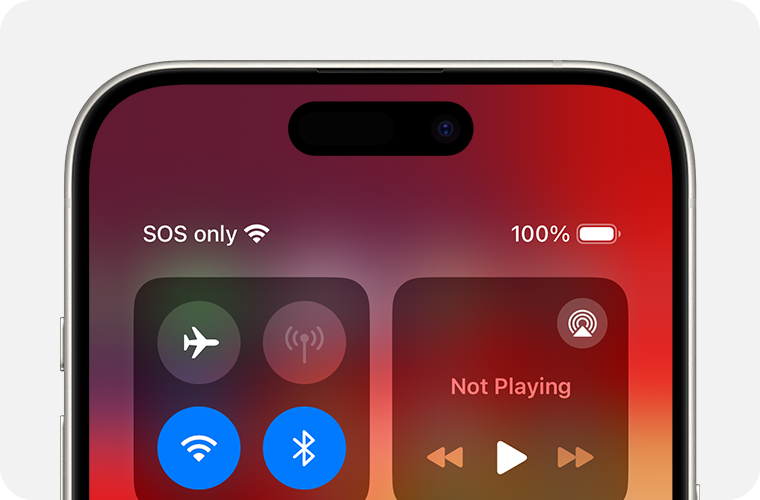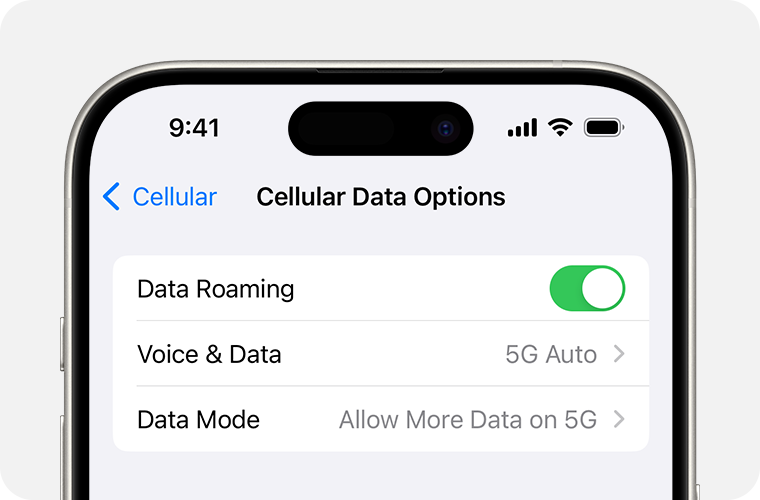If you see SOS or SOS only
If you see SOS or "SOS only" in the status bar, your device isn't connected to a network, but you can still make emergency calls. This feature is available in Australia, Canada and the United States.

Find out more about using Emergency SOS on your iPhone.
Reconnect to your mobile network
To reconnect to your mobile network, follow these steps:
- Go to Settings.
- Turn on Airplane Mode for at least 15 seconds.
- Turn off Airplane Mode.
Restart your iPhone or iPad
Restart your device. If you're not sure how to do this, follow these steps to restart your iPhone or restart your iPad.
Contact your network provider
Issues with your network provider or account may affect your service. Contact your network provider to:
- Verify that your account is active and in good standing.
- Make sure that you're in an area with mobile network coverage and there are no outages in your area.
- Check that your device isn't blocked or barred from receiving mobile services and is set up with the right data plan.
- Ask if your local government requires IMEI registration to use an iPhone that you originally purchased outside your country or region.
Only your wireless network provider can access and manage details about your account:
Update your iPhone or iPad
Update your iPhone or iPad to the latest version of iOS or iPadOS.
Check for a Network Provider Settings update
To manually check for and install a network provider settings update:
- Make sure your device is connected to Wi-Fi.
- Tap Settings > General > About. If an update is available, you'll see an option to update your network provider settings.
- To see the version of network provider settings installed on your device, tap Settings > General > About and look next to Network provider.
If you insert a new SIM card into your iPhone or iPad, you will need to download the network provider settings for your new network provider.
If you have an iPhone with Dual SIM
If you have an iPhone with Dual SIM, follow these steps:
- Go to Settings.
- Tap Mobile Data and tap the mobile data line you'd like to review, then check to see if it's turned on.
- If the mobile data line is off, turn it back on. Then check if you have service.
If you don't see your mobile data line, contact your network provider to set up an eSIM or insert a physical SIM card. If you're using a physical SIM card, remove the SIM card and put it back in.
If your SIM card is damaged, doesn't fit in the SIM tray or you've transferred your physical SIM card from another device, ask your network provider for a new SIM card.
Find out more about removing your iPhone SIM card or iPad SIM card.
If you are travelling internationally
If you're travelling internationally, make sure your device is set up for data roaming.
- In Settings, tap Mobile or Mobile Data. Then:
- If your device has a single SIM card or eSIM, turn on Mobile Data, then tap Mobile Data Options.
- If your device is running Dual SIM or Dual eSIM, turn on Mobile Data, tap the number you want to modify, then tap Mobile Data Options.
- Then, turn on Data Roaming.

If your device uses a 3G network
If you see No Service in the status bar of your device and you have an iPhone 5s, iPhone 5c, or earlier, or an iPad 2 (Wi-Fi + Mobile Data) or earlier, contact your network provider to discuss your options. If you have an iPhone 6 or later or an iPad (3rd generation) or later, follow these steps:
- Update your iPhone or iPad to the latest version of iOS or iPadOS.
- Go to Settings > Mobile Data. Then:
- For iPhone, tap Mobile Data Options, then turn on Enable LTE.
- For iPad, turn on LTE.
If you still see No Service after following these steps, contact your network provider.
iPhone and iPad devices that support 5G networks are not affected by the phasing out of 3G networks.
Get more help
 If your network provider confirms that there's no issue with your account or network, and a hardware issue is suspected, contact Apple Support.
If your network provider confirms that there's no issue with your account or network, and a hardware issue is suspected, contact Apple Support.
If you see an alert next to No Service, learn what you can do.